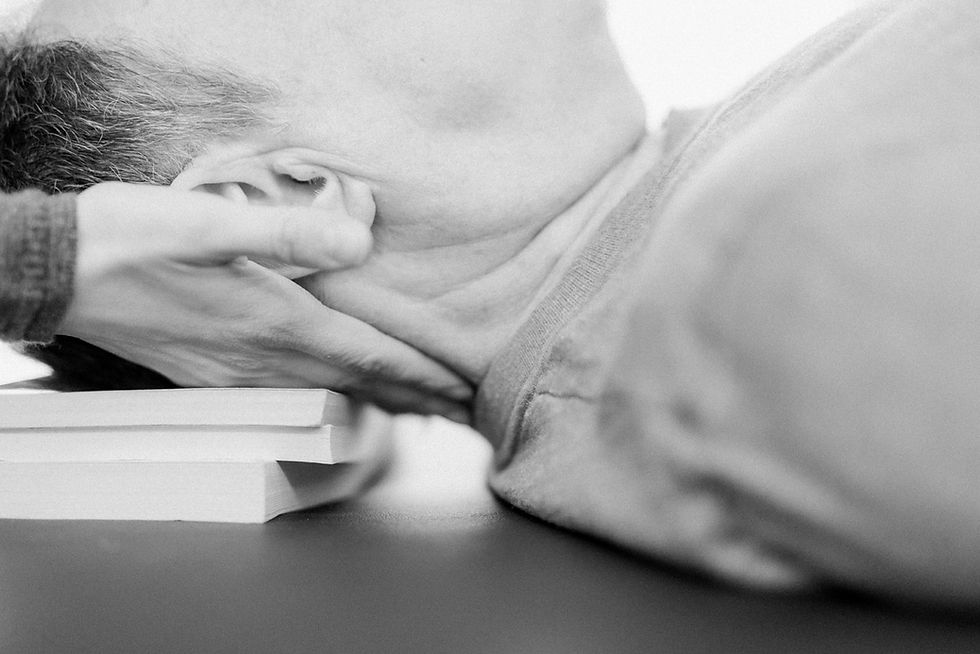What to expect from an Alexander Technique lesson?
- Danielle Amedeo
- Mar 29, 2019
- 3 min read
Updated: May 9, 2019
If you're interested in the benefits of the Alexander Technique but have no idea what to expect, or what's expected of you, read this!
Lesson are constructed in two parts:
First, student and teacher work together to restore length and tone to muscles. This takes place laying on a table and sitting or standing with a chair. The teacher uses light, kind and passive hands to encourage awareness and bring about change.
Second, we look carefully at your daily activities, first simple then increasingly complex, to identify and address problematic thinking and habits. Let's talk about each of these parts in turn.

There is no massage, heavy pressure, athletic movement or exercising of any kind. The student is awake and alert and engaging in a a mindfulness practice...
1) RESTORE PROPER MUSCLE FUNCTION
We all generally understand that muscles contract so we can move and manipulate the world around us, but that's not all that muscles do. Muscles that function properly are lengthened and toned. They are not chronically tense and they work very efficiently. They are rarely fatigued with normal, every-day activity. I talk a bit more about muscle function HERE, and you can read a lot more about it in Neurodynamics, a book that I highly recommend on this work. In an Alexander Technique lesson, our first goal is to reduce chronic tension and bring about length and tone to muscles, which means they work more efficiently. To do this, the student lies on a firm surface, usually a table, with books supporting the head, knees up and feet down.

The teacher then places very passive, kind hands on joints and key postural areas to enourage length- e.g., the knees, sacrum, shoulders, feet, and under the head. There is no massage, heavy pressure, athletic movement or exercising of any kind. The student is awake and alert and engaging in a a mindfulness practice, asking for muscles to let go of tension and lengthen between body parts and along the table. In many ways, the teacher is guiding the student and encouraging him/her/them to get results, rather than "gifting" something to the student that they won't be able to reproduce on their own. After some time, a student will feel like they have spread out on the table. This is literally true, but often a few centimeters of added length along the spine can feel like a mile. Students are calmer and more alert as well.
This goal of "restoration" is also addressed in a chair, sitting and standing, and at a table. These are the foundational movements that apply to almost all human activity - sitting, standing, and bending. Together, the teacher and student look at how to bring about the same length and tone in these foundational movements. Again, there are no exercises or massage. The teacher makes very small adjustments as the student moves through space. We move slowly and thoughtfully.
2) THINKING IN ACTIVITY
Once we've made some progress on the conditions of the musculoskeletal system and we're calmer and more focused, we'll move on to the next major goal in this work, which is to identify habits in activity that are causing the chronic tension and compression of joints. This work happens in foundational movements as well - sitting, standing, and bending, although we may also incorporate other simple movements like crawling. Together, teacher and student deconstruct basic movements into steps and look at each individually to see where habit comes into play, and attempt to make more conscious and constructive choices. After we've had some success here, the teacher may move on to more complex activities like walking, typing, or playing a guitar. The focus here is always on thinking - can we stick to our mindfulness practice, notice a habit, stop, try again. Moving in new ways while inhibiting deeply engrained habits can be a little scary- it feels new and wrong, and sometimes we feel unstable or off-balance. This is all normal, and all part of exploring something new!
A STUDENT, NOT A PATIENT
An Alexander Technique lesson is first and foremost an educational experience. Many of the "hands-on" procedures that teachers do feel nice and bring about relief, but the goal is always to teach the students how to bring about these conditions on their own. You will learn both theoretical and practical tools to help you do this, and the more you incorporate regular practice (i.e. do your homework), the more quickly you will progress. You will be challenged to think in new ways and stay engaged throughout the lesson. If you're looking for a chance to snooze on the table while a practitioner works on your muscles, this isn't the practice for you.






Comments